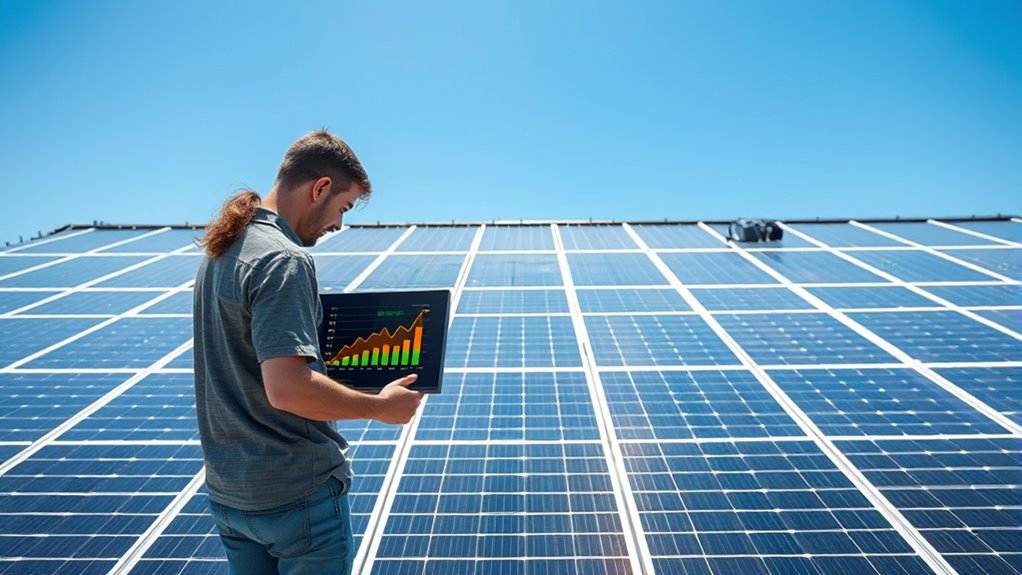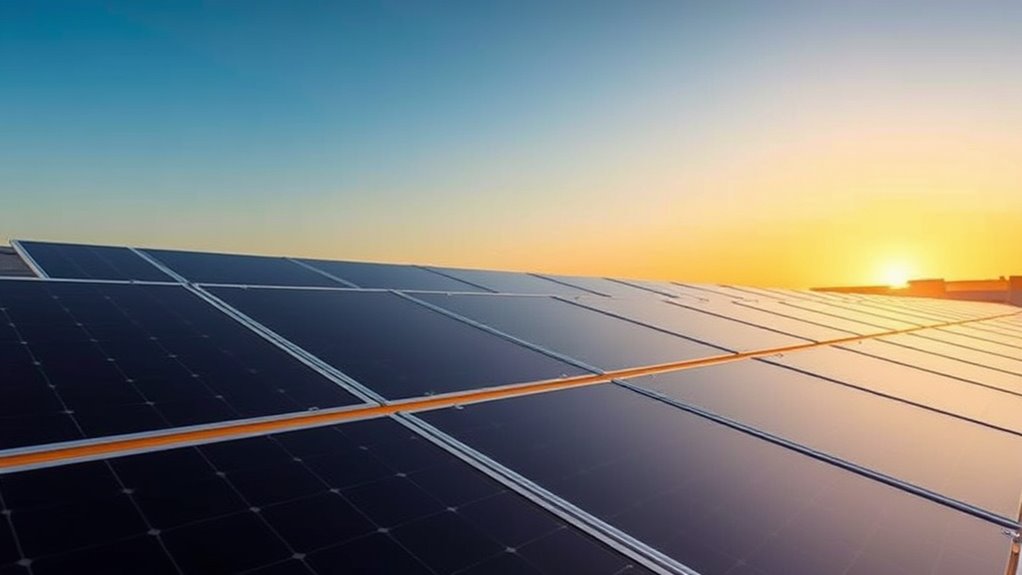To reach ROI within two years, maximize government incentives like rebates and tax credits, which can substantially cut upfront costs. Combine this with energy storage to increase your self-consumption and reduce reliance on the grid, boosting savings. Choose reputable providers familiar with incentive programs to guarantee proper application and system setup. Planning carefully and leveraging these strategies will accelerate your payback period. Keep exploring to discover more ways to fast-track your solar investment success.
Key Takeaways
- Maximize government incentives and rebates during installation to reduce upfront costs.
- Pair solar panels with energy storage systems to increase self-consumption and savings.
- Choose reputable providers experienced with incentive programs and efficient system integration.
- Plan installation timing to align with incentive availability and optimal energy production periods.
- Regularly monitor and optimize system performance to ensure maximum energy savings and quicker ROI.

Have you ever wondered how long it takes for installing solar panels to pay for itself? The answer depends on several factors, but understanding how to maximize your investment can help you reach your ROI faster. One of the most effective ways to do this is by leveraging energy storage systems. By adding a battery to your solar setup, you can store excess energy generated during sunny days and use it during nights or cloudy periods. This reduces your reliance on the grid, lowering your electricity bills even further. Over time, these savings accumulate, helping you recover your investment more quickly. Plus, energy storage can provide backup power during outages, adding an extra layer of security to your home.
Adding batteries to your solar system boosts savings and speeds up your return on investment.
Another substantial factor that can accelerate your payback period is taking advantage of government incentives. Many states and local governments offer rebates, tax credits, and other financial incentives for installing solar panels. These incentives can substantially reduce your upfront costs, making your investment more affordable from the start. For example, federal tax credits can cover a sizable portion of installation expenses, sometimes up to 30%, which directly cuts down the time it takes for your solar system to pay for itself. State and utility-based incentives can further lower costs, sometimes providing cash rebates or additional credits. It’s essential to research what’s available in your area because these incentives vary widely and can substantially impact your ROI timeline.
To make the most of these incentives, you should plan your installation carefully and work with reputable providers who understand the incentive landscape. They can help you navigate the application processes and ensure you claim all the benefits you’re entitled to. Additionally, combining incentives with energy storage systems can amplify your savings, as some programs offer specific benefits for systems that include batteries. This approach not only boosts your energy independence but also speeds up your payback period by maximizing savings on energy costs.
In essence, your path to a quicker ROI involves smart planning and leveraging available resources. Installing energy storage allows you to maximize self-consumption and reduce grid dependence. Securing government incentives lowers your initial investment, which directly shortens the time needed to break even. When you combine these strategies, you’re positioning yourself to reach that two-year ROI milestone sooner rather than later. With a little research and planning, you can make your solar investment more cost-effective and enjoy the financial benefits sooner. Additionally, understanding the onboard experience can help you choose the right system and providers to optimize your solar journey.
Frequently Asked Questions
How Do Local Incentives Affect Payback Periods?
Local incentives like rebates and tax credits markedly shorten your solar panel payback period. When you take advantage of local rebates, you reduce upfront costs, making installation more affordable. Tax credits further cut expenses by lowering your tax bill. These incentives boost your return on investment and help you reach ROI faster. By researching and applying for available local incentives, you maximize savings and speed up your solar energy benefits.
What Maintenance Costs Are Involved Over Solar Panel Lifespan?
Imagine balancing a long-term investment with occasional upkeep. Over a solar panel’s lifespan, you’ll face maintenance costs like inverter replacements and addressing panel degradation. Inverter replacements are typically needed every 10-15 years, while panel degradation gradually reduces efficiency, increasing your costs slightly over time. Staying proactive, scheduling regular inspections, and budgeting for these expenses ensures your solar system continues functioning at its best, maximizing your savings.
Can Energy Storage Systems Impact ROI Timelines?
Energy storage systems can substantially impact your ROI timelines through battery optimization and grid integration. By efficiently managing stored energy, you reduce reliance on costly grid power, saving money quickly. Properly integrated batteries ensure you use stored energy during peak rates, accelerating your payback period. Investing in advanced battery management and seamless grid integration helps you reach ROI faster, making your solar investment more financially rewarding over its lifespan.
How Does Household Energy Usage Influence Payback Calculations?
Isn’t it ironic that your energy consumption patterns can actually help pay back your solar panels faster? By optimizing appliance efficiency and reducing unnecessary usage, you lower your overall energy needs. This means your solar system generates more than enough, accelerating your ROI. So, the less you waste, the quicker you see the benefits—turning your household habits into a smart investment strategy with real savings.
What Emerging Technologies Could Further Reduce Payback Time?
Emerging technologies like advanced inverter technology and bifacial panel innovation can substantially cut your payback time. Advanced inverters optimize energy conversion, boosting efficiency and reducing costs. Bifacial panels harness sunlight from both sides, increasing power output without extra space. By adopting these innovations, you can maximize your solar system’s performance, accelerate your ROI, and reach your financial goals faster. Staying ahead with these tech advances ensures you get the most out of your investment.
Conclusion
By following these strategies, you can turn your solar investment into a lightning bolt of savings, cutting your payback period in half. Every dollar saved accelerates your journey toward true energy independence, making your solar panels not just a roof feature but a beacon of financial wisdom. Remember, patience and smart choices are the wind beneath your wings—pushing you closer to that two-year ROI milestone faster than you ever thought possible.









